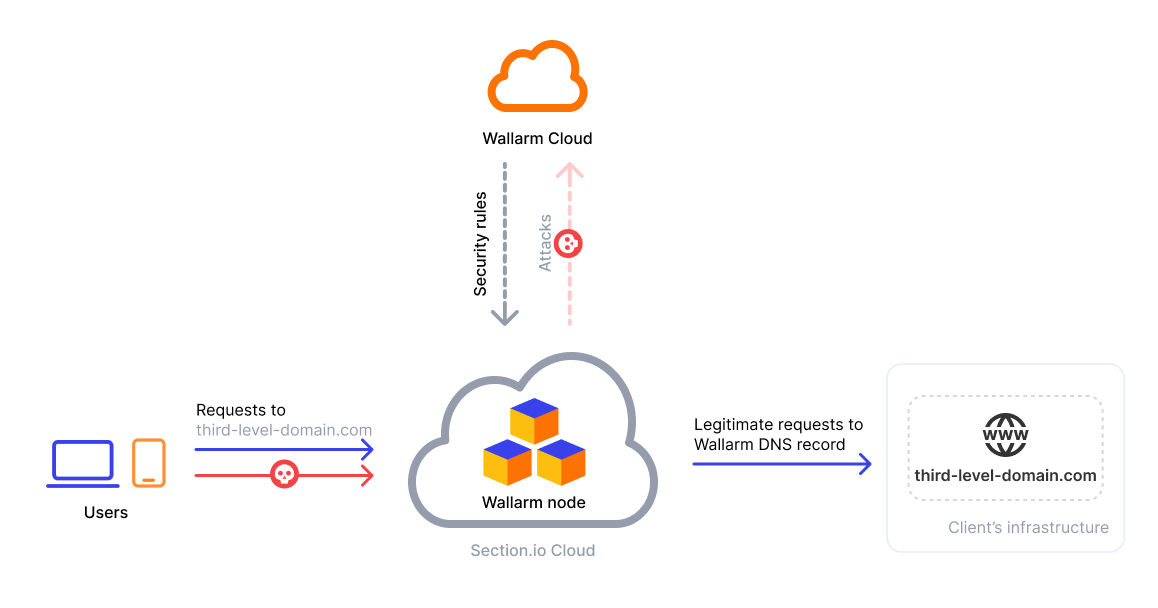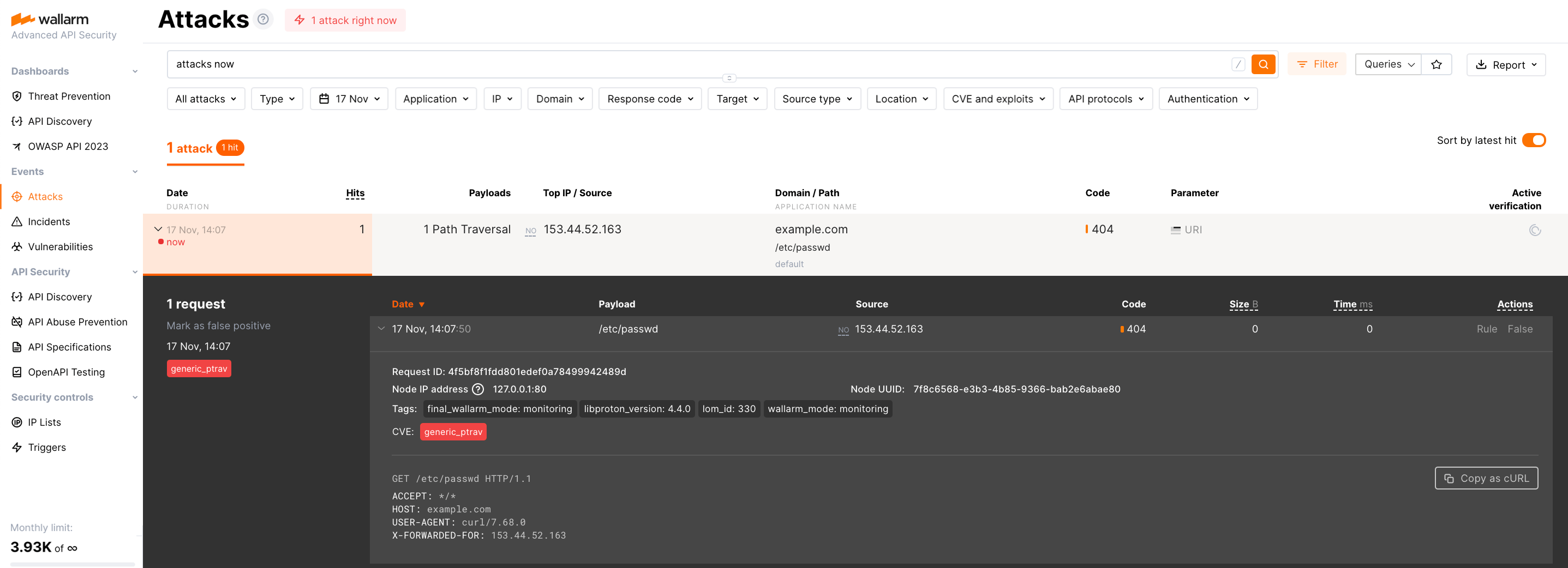Deploying Wallarm Node with Section.io¶
Section is a Cloud-Native Hosting system that enables easy deployment of a Wallarm node. By routing traffic through it as a reverse proxy, you can effectively mitigate malicious traffic without adding third-party components to your application's infrastructure.
Use cases¶
Among all supported Wallarm deployment options, this solution is the recommended one for the following use cases:
-
You are looking for a security solution that is quick and easy to deploy for protecting lightweight services.
-
You lack the capability to deploy Wallarm nodes within your hosting infrastructure.
-
You prefer a hands-off approach to deployment, avoiding the management and maintenance of Wallarm filtering nodes.
Limitations¶
The solution has certain limitations:
-
For high traffic analysis and filtration, the use of CDN nodes is not recommended.
-
Deployment of the CDN node type is not supported under the Free tier plan.
-
With the CDN node you can protect the third-level (or lower, like 4th-, 5th- etc.) domains. For example, you can create CDN node for
ple.example.com, but not forexample.com. -
The
collectdservice is not supported. -
Direct application setup through standard procedures is unavailable. Contact the Wallarm support team for configuration assistance.
-
Custom blocking pages and error codes are not configurable. As a default, CDN node returns a 403 response code for blocked requests.
Requirements¶
-
The website to be protected must be third-level (or lower) domain
-
The IPv4 associated with the website (IPv6 not supported)
-
Sufficient access permissions to edit the DNS records of the domain
-
The Administrator role assigned to the user configuring the CDN node
How CDN node works¶
Wallarm CDN node operates as a reverse proxy to the protected server. It analyzes incoming traffic, mitigates malicious requests and forwards legitimate requests to the protected server.
What can be protected with CDN node
With the CDN node you can protect the third-level (or lower, like 4th-, 5th- etc.) domains. For example, you can create CDN node for ple.example.com, but not for example.com.
As for the other characteristics of the Wallarm CDN node:
-
Hosted by the third-party cloud provider (Section.io), so no resources are required from your infrastructure to deploy the CDN node.
Uploading request data to the third-party cloud provider
Some data on processed requests is uploaded to the Lumen service.
-
Uploads some request data to the Wallarm Cloud. Learn more about uploaded data and cutting the sensitive data
-
Operates in the safe blocking mode relying on the IP graylist contents to identify suspected traffic and block it.
To change the mode, use the corresponding rule.
-
The CDN node is fully configured via Wallarm Console UI. The only setting to be changed in another way is adding the Wallarm CNAME record to the protected resource's DNS records.
-
You can request the Wallarm support team to perform application configuration for your node.
CDN node deployment¶
-
Open Wallarm Console → Nodes → CDN → Create node.
-
Input the domain address to be protected, e.g.
ple.example.com.The specified address must be the third-level (or lower) domain and not contain the scheme and slashes.
-
Make sure Wallarm correctly identifies the origin address associated with the specified domain. Otherwise, please change the automatically discovered origin address.
Dynamic update of origin address
If your hosting provider dynamically updates the origin IP address or domain associated with the protected resource, please keep the origin address specified in the CDN node configuration up to date. Wallarm Console enables you to change the origin address at any time.
Otherwise, requests will not reach the protected resource since the CDN node will try to proxy them to an incorrect origin address.
-
Wait for the CDN node registration to finish.
Once the CDN node registration is finished, the CDN node status will be changed to Requires CNAME.
-
Add the CNAME record generated by Wallarm to the DNS records of the protected domain.
If the CNAME record is already configured for the domain, please replace its value with the one generated by Wallarm.
Depending on your DNS provider, changes to DNS records can take up to 24 hours to propagate and take effect on the Internet. Once the new CNAME record is propagated, the Wallarm CDN node will proxy all incoming requests to the protected resource and block malicious ones.
-
If required, upload the custom SSL/TLS certificate.
Wallarm will generate the Let's Encrypt certificate for the CDN node domain by default.
-
Once DNS record changes propagated, send test attack to the protected domain:
- If originating IP address is graylisted, the node will both block the attack (the HTTP response code is 403) and record it.
-
If originating IP address is not graylisted, the node will only record detected attacks. You can check that attacks have been registered in Wallarm Console → Attacks:
Next steps¶
Wallarm CDN node is successfully deployed!
Learn the Wallarm configuration options:
-
System event notifications configured via native integrations with DevOps tools and triggers
-
Using the Nodes section UI to update the origin address of the protected resource, upload the custom SSL/TLS certificate and delete CDN nodes
-
Selecting whether to use the Varnish Cache to speed up your content delivery.
CDN node troubleshooting¶
What do CDN node statuses mean?¶
The following statuses may appear in Wallarm Console → Nodes for CDN nodes:
-
Registering: Wallarm registers the CDN node in the cloud provider.
Required action: wait for the Requires CNAME status to add the Wallarm CNAME record to the protected domain's DNS records.
-
Requires CNAME: Wallarm CNAME record is not added to the DNS records of the protected domain or it is added but not propagated yet.
Required action: add the CNAME record provided by Wallarm to the DNS records of the protected domain or wait for the changes to take effect on the Internet.
If changes do not take effect for more than 24 hours, please check that your domain provider successfully updated the DNS records. If so, but the Not propagated yet status is still displayed in Wallarm Console, please contact the Wallarm technical support.
The next expected status is Active.
-
Configuring: Wallarm processes changed origin address or SSL/TLS certificate.
Required action: wait for the Active status.
-
Active: Wallarm CDN node mitigates the malicious traffic.
Required action: none. You can monitor the events the CDN node detects.
-
Deleting: Wallarm deletes the CDN node.
Required action: none, please wait for deletion to be finished.
How to identify the CNAME record propagated?¶
The Nodes section of Wallarm Console displays the actual status of whether the Wallarm CNAME record took effect on the Internet. If the CNAME record is propagated, the CDN node status is Active.
In addition, you can check the HTTP response headers with the following request:
If the Wallarm CNAME record is propagated, the response will contain the section-io-* headers.
If the CNAME record is not propagated for more than 24 hours, please check that your domain provider successfully updated the DNS records. If so, but the Not propagated yet status is still displayed in Wallarm Console, please contact the Wallarm technical support.
The CDN node is highlighted in red in the Nodes section. What does it mean?¶
If the CDN node is highlighted in red in the Nodes section, an error occurred during its registration or configuration due to the following possible reasons:
-
Unknown error while registering the node in the third-party cloud provider
Required action: contact the Wallarm technical support.
-
Invalid custom SSL/TLS certificate
Required action: make sure the uploaded certificate is valid. If not, upload the valid one.
The CDN node highlighted in red does not proxy requests and as a result, does not mitigate malicious traffic.
Why the CDN node could disappear from the node list in Wallarm Console?¶
Wallarm deletes CDN nodes with CNAME records left unchanged for 10 or more days since the moment of the node creation.
If you find the CDN node disappeared, create a new node.
Why is there a delay in the update of the content protected by the CDN node?¶
If your site is protected by the CDN node and you notice that when you change your data, the site is updated with a sensible delay, the probable reason may be the Varnish Cache which speeds up your content delivery, but the cached copy on the CDN may be updated with a delay.
Example:
-
You have Varnish Cache enabled for your CDN node.
-
You updated prices on your site.
-
All requests are proxied via CDN, and the cache is not updated immediately.
-
Site users see the old prices for some time.
To resolve the problem, you may disable Varnish Cache. To do so, proceed to Nodes → CDN node menu → Disable Varnish Cache.



